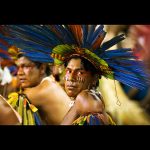The Endangered Language of the Bororo in Brazil
Traveling in Brazil along the 15th parallel is no easy business. From the coastline, the country’s capital, Brasilia, is a whole 24 hours in bus. Add another 10 hours and the bus may reach the rude landscape surrounding the bustling Rondonópolis in Brazil’s Mato Grosso region. This is a backwoods more laden with yellowing grasses and sandy stretches than woods, and cross-sectioned by the slow moving Guaporé and Cuiabá rivers just beyond the reaches of the Amazon.
The lusophone cowboys established here bring their cattle to rummage the remaining arable land, increasingly impeding on the local Indian population. This population, which is probably the equivalent of a large American high school, slightly above 1,600 (2012 estimate), is a subject of anthropological and linguistic interest. Their societal structure has been heavily studied despite their remoteness, and their language observed numerous times. Not to be confused with an African people by the same name, a majority of the Bororo tribe speak Boe Wadáru, a UNESCO classified, highly endangered tongue. The Bororo which actually means “village court”, have seen the Bolivian branch of their tribe disappear and the sister language, Umutina, lose its last speaker in 1988. Regardless, Boe Wadáru is a symbol of linguistic survival considering encroaching cowboys aren’t the first in a long history of obstacles that arrived with Portuguese colonization.
Probably one example of hardship is living in an area 600 times smaller than formerly, when their territory extended from Bolivia to Goiàs. The Eastern branch, or current Bororos, became isolated from the whole following intensive gold excavations and road construction in the 18th and 19th centuries. After violent confrontations resulting from Portuguese infrastructure in the Bororo heartland, diamond hunters turned up.
The latest linguistic obstacle was the Salesian Indigenous mission. Now partnered with the UN, the religious order mandated the youth in two main villages to abandon their native language until the 1970s when they reversed their policy. The tribe’s relentless efforts for cultural preservation are a major factor behind today’s bilingual education with Portuguese, and the bilingualism of the population. In fact, the 1970s was a turning point because since then the population recovered from a trough at 600 (19th century population is estimated close to 10,000). It is probably these cataclysmic events that have attracted so much attention. Anthropologists have closely followed the Bororo ever since a 1935 study by Claude Levi-Strauss. Linguistic studies, however, are much more rare.
Rodrigues (1999) confirmed work by Manson and Greenberg, in 1950 and 1957 respectively, concerning Boe Wadáru belonging to the Macro-Jê linguistic phylum. Earlier research, by Rivet and Schmidt in the 1920s, had suggested an isolated case with possible linkage to the now extinct Otuké language. Grammar has been scrutinized as well. Linguistic field-research by Rafael Nonato in 2008 exposes phonological and lexical differences between the Boe Wadaru Latin script and Portuguese script, drawing in part from A Grammar of Bororo (1979) by Thomas Crowell. The latter’s book also mentions that Boe Wadaru borrows from Portuguese, notably “gato” meaning “cat” and “kaxiworo” which is similar to “cachorro” meaning “dog”. Otherwise, it is not the briefest of languages with “baitemannageo” meaning “men’s house” (an important structure in their villages) and “joruduiwabokwa” meaning “stupid”.
One particularity in Boe Wadaru is the adjective “atugo” meaning “painted, decorated” also refers to “jaguar” when used substantively. Finally, interesting for cognitive researchers, is that numbers above five are usually expressed in Portuguese, highlighting the non-commercial society the tribe once was.
Currently however, commerce is on the rise due to eager tourists who endured the extremely long bus-rides. This distracts the Bororo from their traditional hunting activities which in any case face dwindling animal populations, but doesn’t distract from traditional funeral rites, demonstrating their attachment to local culture.
 While Portuguese is the single official language of Brazil, the bilingual education (albeit with undertrained teachers), and young population also encourage continued survival for Boe Wadáru. However there is constant preoccupation that a future generation won’t have the same preservation commitment, and with only 1,000 some speakers and a continuously constrained land allotment, extinction may not be so far away. As always, more research, media, and support help save these precious indigenous varieties.
While Portuguese is the single official language of Brazil, the bilingual education (albeit with undertrained teachers), and young population also encourage continued survival for Boe Wadáru. However there is constant preoccupation that a future generation won’t have the same preservation commitment, and with only 1,000 some speakers and a continuously constrained land allotment, extinction may not be so far away. As always, more research, media, and support help save these precious indigenous varieties.
For an overview of our translation expertise, visit our medical and life science translation service page.
Category: Foreign Language








